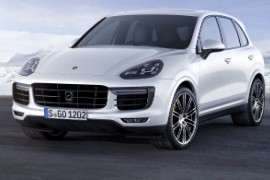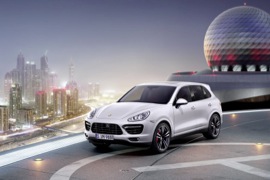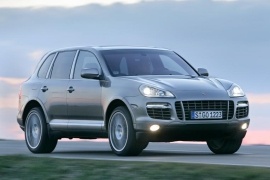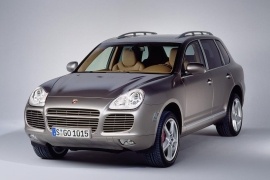PORSCHE Cayenne Turbo S Models/Series Timeline, Specifications & Photos
First production year: 2006
Engines: Gasoline
Body style: SUV (Sports Utility Vehicle)
The Turbo S version was the sportiest version for the second generation of the Porsche Cayenne and, along with the rest of the stable, it received a facelift for the 2015 model year.
When it was introduced in 2006, the Cayenne Turbo S offered 520 hp and it was built to tackle the Mercedes-Benz ML63 AMG. It was offered with an off-road package as well, an option that couldn't find its way on the three-star badge contender. Fast forward in 2015 and the Cayenne Turbo S received the last upgrade before the change.
The exterior of the 2015 Cayenne Turbo S was enhanced with a sharper design and clear lines. The front fenders, the grille, and the headlights were entirely new, with LED for daytime running lights and, for the Turbo version, full-LED. The grille was still divided into three main areas, with the biggest one kept for the engine. The underbody aluminum shield was replaced by a black plastic one. In the back, the roof-spoiler became a standard fit for the entire range.
Inside, the connection with the 911 range was more obvious due to the five-dials instrument cluster and the centrally-mounted tachometer. The new, tall and slim, air-vents were inspired by the Panamera sedan, but on the center console, the buttons from the PTM system were an updated version of those found in the first generation Cayenne.
Under the hood, the revised engine offered 20 hp more than its predecessor. It was the same twin-turbo 4.8-liter V8 unit and it was paired to an 8-speed Tiptronic (automatic) transmission, with manual override to select gears. Like the Turbo version, it was offered with a standard air-suspension but, to ensure a better performance package, it received a standard Porsche Composite Ceramic Brakes system with 420 mm (16.5”) front rotors.
The Cayenne Turbo S was the top of the range Cayenne and it featured more standard features and more power than any other Porsche Cayenne. And yes, it was the most expensive version.
As the flagship of the Cayenne army, the Turbo S was well received by those who were looking for a faster SUV. And it wasn't only the speed, but also the cornering speed that the Turbo S was capable of. Unlike its siblings, most of the performance-oriented technical features were fitted as standard, including the Porsche Adaptive Suspension Management or the Porsche Torque Vectoring system.
The Turbo S had numerous exterior features such as air intake grilles, headlight housing, and mirror components painted in a black high-gloss finish. The standard 21-inch 911 Turbo II wheels with colored Porsche crest were painted in gloss black on the inside, which was an exclusive styling for the Cayenne Turbo S.
Inside, the Cayenne Turbo S featured a two-tone leather interior with new color and color distribution specifically for the model. These interior features were available in the combination black/carrera red and black/luxor beige. The Carbon interior package complemented the leather features and emphasized the quality of the materials.
The engine was based on the 4.8-liter V8 unit installed in the Cayenne S and Cayenne Turbo, but with a higher compression ratio that led to 50 more hp. The standard transmission was an 8-speed Tiptronic S.
In 2007, the entire Cayenne lineup received a well-deserved facelift. But now, everyone knew that the flagship will have the Turbo S badge on it.
After the first shock passed and the market understood that a Porsche SUV might be one of the best ideas to save the famous German sports-car brand, the critics started to lower their voices and customers started to order more. It was the perfect Porsche for a family, an excellent SUV, and an awarded off-road vehicle. Moreover, between the launch of the Cayenne and the facelift, almost 160.000 units were sold. It was a huge success.
For the 2007 facelift, the German car-manufacturer listened to its customers and got rid of the Porsche 996-inspired headlights. The new ones featured a clear lens over the lamps and they were re-shaped. A new, vertical, daytime running light appeared on the outer side of the side-scoops and the center grille was smaller. The Cayenne Turbo S rode on 18” light-alloy wheels. It was fitted as standard with PASM (Porsche Active Suspension Management) and air suspension.
The interior was almost unchanged when compared with its non-facelifted version. It featured the same seats and standard audio system. For the Turbo S version, standard two-tone leather upholstery was fitted as standard.
The Cayenne Turbo S was fitted with a 550 hp direct-fuel injection system and VarioCam (variable valve timing). Despite offering more power, it obtained a better fuel-efficiency. A longer transmission ratio allowed the engine to run at a lower rpm for the same speed as its predecessor. For the all-wheel-drive system, the Porsche Traction Management (PTM) was enhanced to offer better traction in all conditions.
In 2006, Porsche Cayenne received a new version, which became the new flagship in the Porsche SUV family: the Turbo S. It was its most powerful version.
After only four years, Porsche understood that despite all the odds and all the bad comments regarding the new SUV, the Cayenne was sold well. Soon it became clear that the medium-sized SUV saved the German sports-car and it managed to be a top-seller in its market segment.
The exterior look was inspired by the 911, with Bi-xenon headlights that resembled those installed on the 911 - 996 version. The front bumper was tall and crossed by four grilles. As any SUV on the market, the Cayenne featured a tall greenhouse, which was somehow unusual for the Porsche brand. It was fitted with special light-alloy wheels. In the back, a quad exhaust system with rounded tips was installed and an aluminum shield was seen under the bumper.
Inside, the gear-selector was carried-over from 911. The instrument panel featured two large round dials with a central multi-functional display. A tall center console separated the front passengers. The power-adjustable leather front seats were accompanied by the rear leather bench, which featured a split-backseat to extend the trunk space. For the instrument cluster, the five-dials layout was kept, with a center LCD and two small dials. The 6-speed automatic (Tiptronic) gearbox was fitted as standard, and the steering wheel featured buttons to shift gears in manual mode.
The engine was an upgraded version of the V8 Bi-turbo found in the Cayenne Turbo. It offered 521 hp and it was able to keep up with sports-cars, but in a vehicle that could go off-road with a ground clearance up to 28 cm (11”). The off-road Technology Package option offered a locking rear differential.



